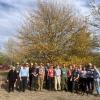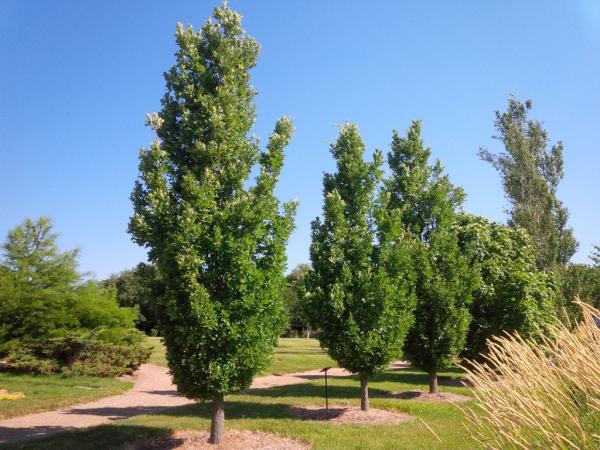Editor's Picks
Plant Focus
This event packed into four days a comprehensive, entertaining, and varied tour of some of Belgium's best oak collections and gardens. The event was attended by a total 30 participants and 11 guides/hosts. The summary report below is authored by several participants, each covering a different section of the event. A detailed report will be published in the IOS Journal. Thank you to the authors who volunteered to write these reports, to our hosts and guides at each of the venues, and especially to Charles Snyers for organizing the whole event.
Day 1, May 29 (morning): Arboretum Kalmthout
by Tibo Deckers
The Belgian Open Oak Days officially started with a visit to Hemelrijk, but for those interested, there was an opportunity for an extra morning visit to Arboretum Kalmthout.
The arboretum is especially known for its Hamamelis collection. However, our guide, Johan Possemiers, showed us that the collection is much broader and more diverse. More on that later.

A large number of people had signed up for the guided tour. After gathering at the reception, we got started right away. Johan began with some background information about the history of the arboretum. He told us about Robert and Jelena De Belder, who, together with Robert's brother George, acquired the property when it was a nursery created by Charles Van Geert. They then developed it as a private botanical garden. He also explained that the nearby train station was specially built to transport trees and plants to the nursery. Today, the station is still in use, making it easy to travel there by public transport.
The tour then began, taking us past not only many remarkable oaks but also several other beautiful trees. Just a few steps in, Johan stopped us at an Eriobotrya japonica. Years ago, it would have been unthinkable for this species to thrive in Belgium, but due to milder winters caused by climate change, it is now possible.
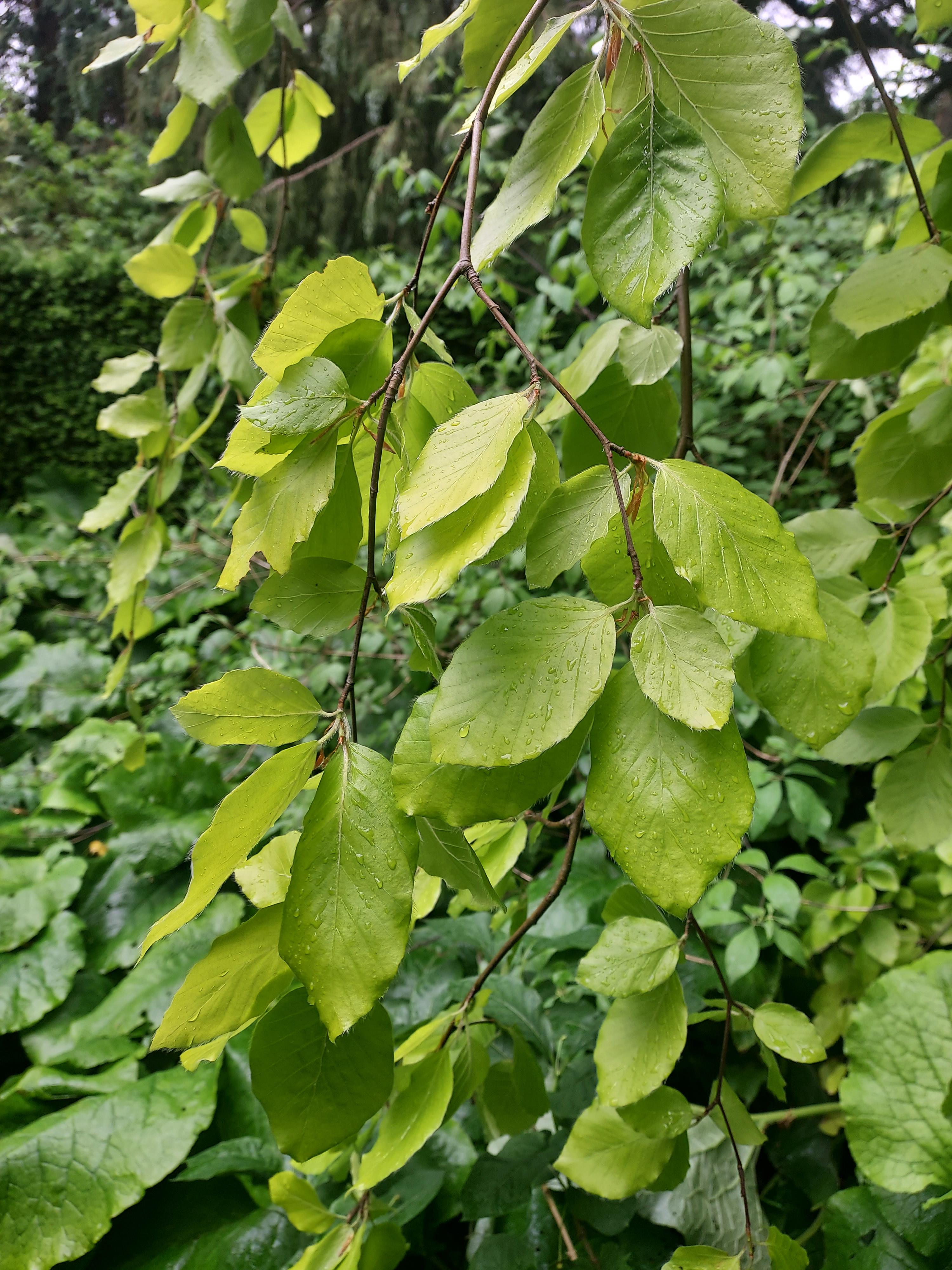
We followed our guide further, encountering many trees that clearly showed the diversity of the arboretum. Some examples include Pterostyrax hispida, Cladrastis kentukea, Araucaria angustifolia, Fagus sylvatica 'Aurea Pendula', Torreya taxifolia 'Argentea', Liquidambar orientalis, and one of the few specimens of Emmenopterys henryi that has ever bloomed in Belgium.

When we paused at the Fagus sylvatica 'Aurea Pendula', Johan shared an interesting fact. He showed us that the leaves are covered in tiny hairs, which the tree uses to absorb water. So, it’s not only the roots that take up water; after rain or morning dew, the leaves can also absorb moisture. Johan then asked if this phenomenon has ever been observed or studied in Quercus species. Feel free, as a reader, to share any insights or observations you might have on this topic.1
We continued walking past several species of Stewartia and Halesia, until we reached the rose garden, which looked stunning at this time of year. It was noteworthy that, due to climate change, the blooming period now tends to occur earlier than in previous years. A little further on, we saw something remarkable again: a blooming Phyllostachys nigra. Arboretum Kalmthout continued to surprise us.

Later in the tour, we also came across several Quercus species, including Quercus ×hispanica 'Lucombeana'. Johan pointed out recent changes in the naming of this hybrid (Q. cerris × Q. suber); it had temporarily been called ×crenata, but the name has now been reverted to ×hispanica. Until the next renaming, we will stick to this latest name.

At the far end of the arboretum, we came across a beautiful specimen of Q. ×leana (Q. phellos × Q. velutina). It was the perfect moment for our first group photo. After that, it was time to start wrapping up the visit. On our way back to the reception, Johan showed us some other species, including Q. velutina and an impressive Q. frainetto, both grafted.

After a pleasant lunch, we passed by a Q. ithaburensis subsp. macrolepis 'Hemelrijk Silver' on the parking lot of the arboretum. The cultivar name was a nice hint towards our next activity.

Day 1, May 29 (afternoon): Hemelrijk
by Stefan Vidts
Returning to Hemelrijk: A Personal Journey Among Oaks
Thanks to an invitation from the International Oak Society, I had the privilege of revisiting Hemelrijk—a place that holds profound personal significance. Over 15 years ago, I lived nearby and often wandered its quiet paths, finding peace beneath the trees. Then, as now, Hemelrijk felt like a sanctuary—a place where time slows and the trees seem to whisper their stories to those who pause to listen.

Set across 140 hectares in Essen, Belgium, the property was transformed from a rigid expanse of historic peatland into a flowing, dreamlike landscape by the renowned English landscape designer Russell Page. He retained the estate’s original geometric structure of beech- and oak-lined avenues (Fagus sylvatica and Quercus robur) and drainage ditches, but softened it with sweeping, organic forms. A vast central pond was dug, and the excavated soil was used to sculpt gentle hills, creating a dynamic interplay of moist and dry zones—ideal for a wide array of woody plants. For me, this landscape has always evoked the mythical serenity of the Elysian Fields.

At the heart of Hemelrijk is its nice oak collection. Planted primarily in the 1960s and 1980s, the trees are now reaching 50 to 60 years of age. This living archive was curated by Robert De Belder, one of the visionary founders of the International Dendrology Society, and his wife Jelena. Their global collecting efforts brought rare seeds of woody plants to Hemelrijk, including diverse oak species, making the collection both a scientific resource and a living tribute. Every branch speaks to their legacy. Today, their children, Dianne and Danny, graciously welcomed us as our hostess and host.
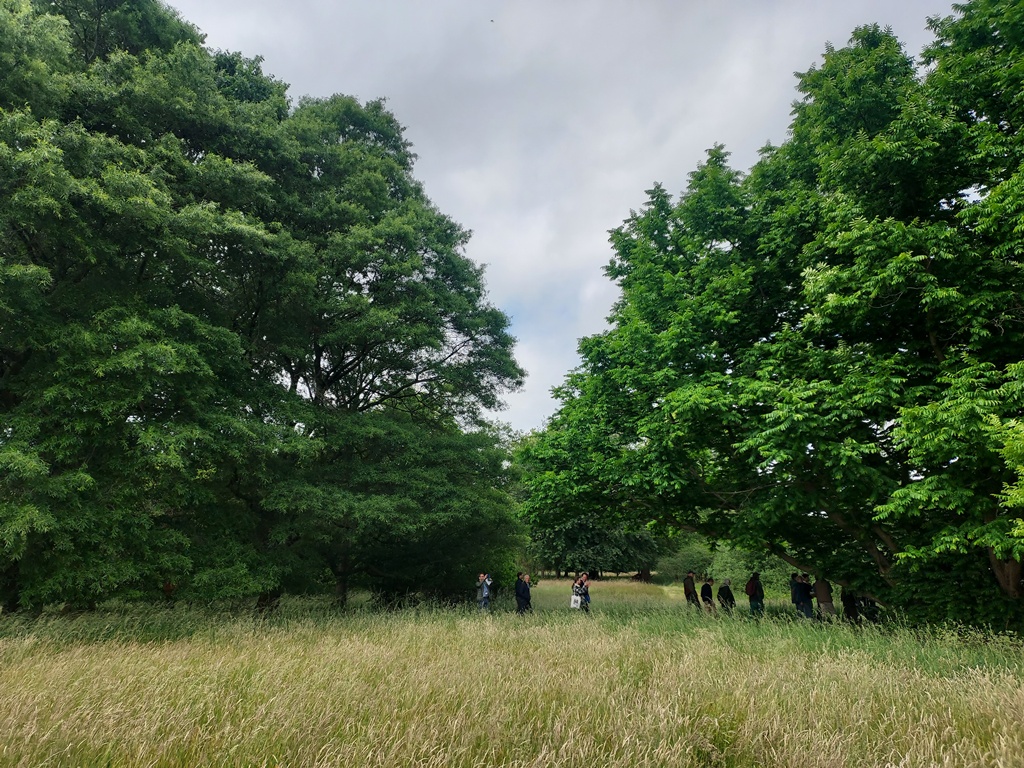
It is far from a conventional arboretum. The oaks are grouped with other trees and shrubs by region and plant associations, forming naturalistic groups of open woodland around the pond. Multiple seedlings of the same species grow together, echoing the structure of wild ecosystems rather than following a strict alphabetical or taxonomic order. Walking through these groves feels less like touring a garden and more like being immersed in a living, breathing open forest shaped by purpose and passion.
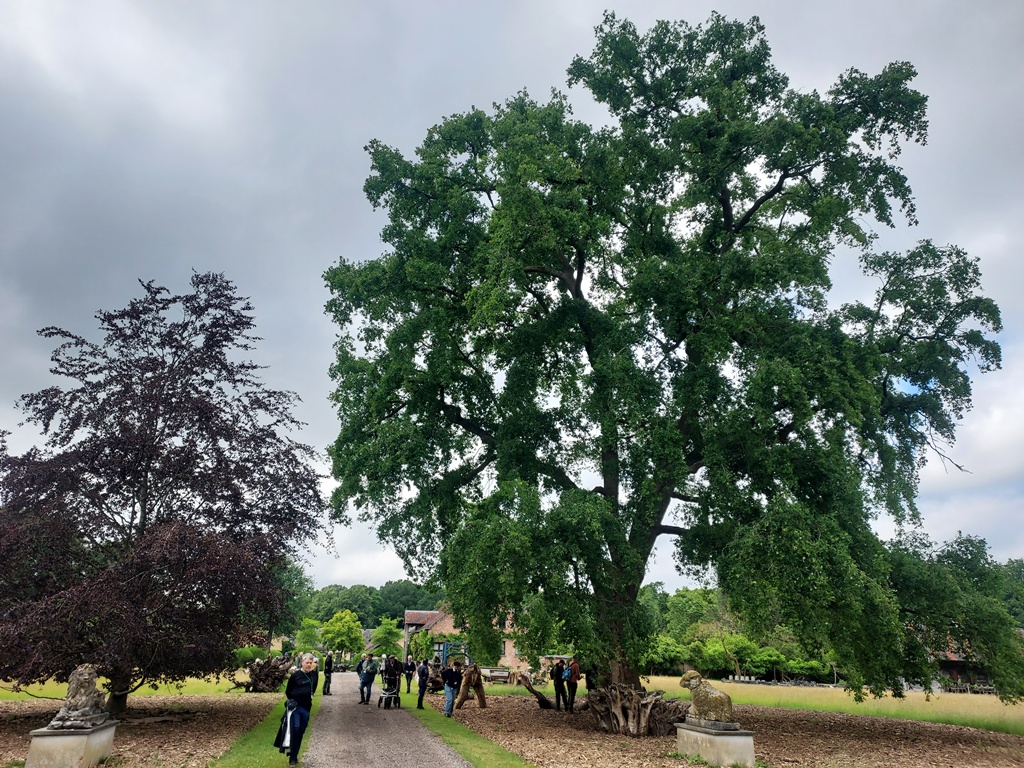
Our visit ended with a group photo beside the stately Quercus robur 'Pendula', one of the largest known specimens of this elegant weeping oak cultivar. It stands near the location of the former castle and beside the house where Jelena spent her final years—planting, nurturing, welcoming fellow plant lovers from all corners of the world.

The estate boasts a wide range of other woody plants, including own selections of Hamamelis cultivars, Hydrangea paniculata and Rhododendron seedlings, aside from the diversity of oaks. Here are a few standout specimens where we paused to verify identification and take measurements: Q. dentata (seedlings) and Q. dentata ‘Carl Ferris Miller’, Q. petraea, Q. macrocarpa, Q. ×rosacea, Q. ilicifolia, a group of Q. phellos, Q. falcata, Q. ×hispanica ‘Wageningen’, Q. variabilis, Q. velutina, Q. cerris, Q. castaneifolia 'Green Spire'.
Day 2, May 30 (morning): Three city parks in Brussels
by Jan Awouters
Parc Tenbosch
In 1885, the grandparents of Jean-Louis Semet purchased a one-hectare plot in Ixelles, a municipality at the time next to Brussels and now part of the Brussels-Capital Region, to build a castle with a garden, orchard, and vegetable beds. In 1902, his parents took over the estate, and in 1953, Jean-Louis expanded it by acquiring adjacent land. He transformed the garden into a private arboretum, sourcing rare and interesting trees—often from the Hillier nursery in England. By 1982, the estate became public property under the Brussels-Capital Region and was opened as a park. Today, over 100 tree species thrive there, including some winter-sensitive species like Umbellularia californica and Nothofagus obliqua, thanks to the city’s microclimate.
Of special interest is the oak collection. Near the entrance stands a mature Q. ilex, once considered marginal for Belgian winters but now thriving due to climate change. Nearby, Q. bicolor grows well, and an unnamed, vigorous hybrid oak in the playground sparks debate—possibly involving Q. acutissima or Q. aliena. Quercus macrocarpa with a pale underside might be Q. ×schuettei (a hybrid with Q. bicolor), pending confirmation.
Jardin du Roi and Abbaye de la Cambre

The tour continues to the King’s Garden, laid out under King Leopold II. Here, Q. ×hispanica ‘Wageningen’ lines a central lawn, and an impressive Q. cerris leads us to the former gardens of the Ter Kameren Abbey.
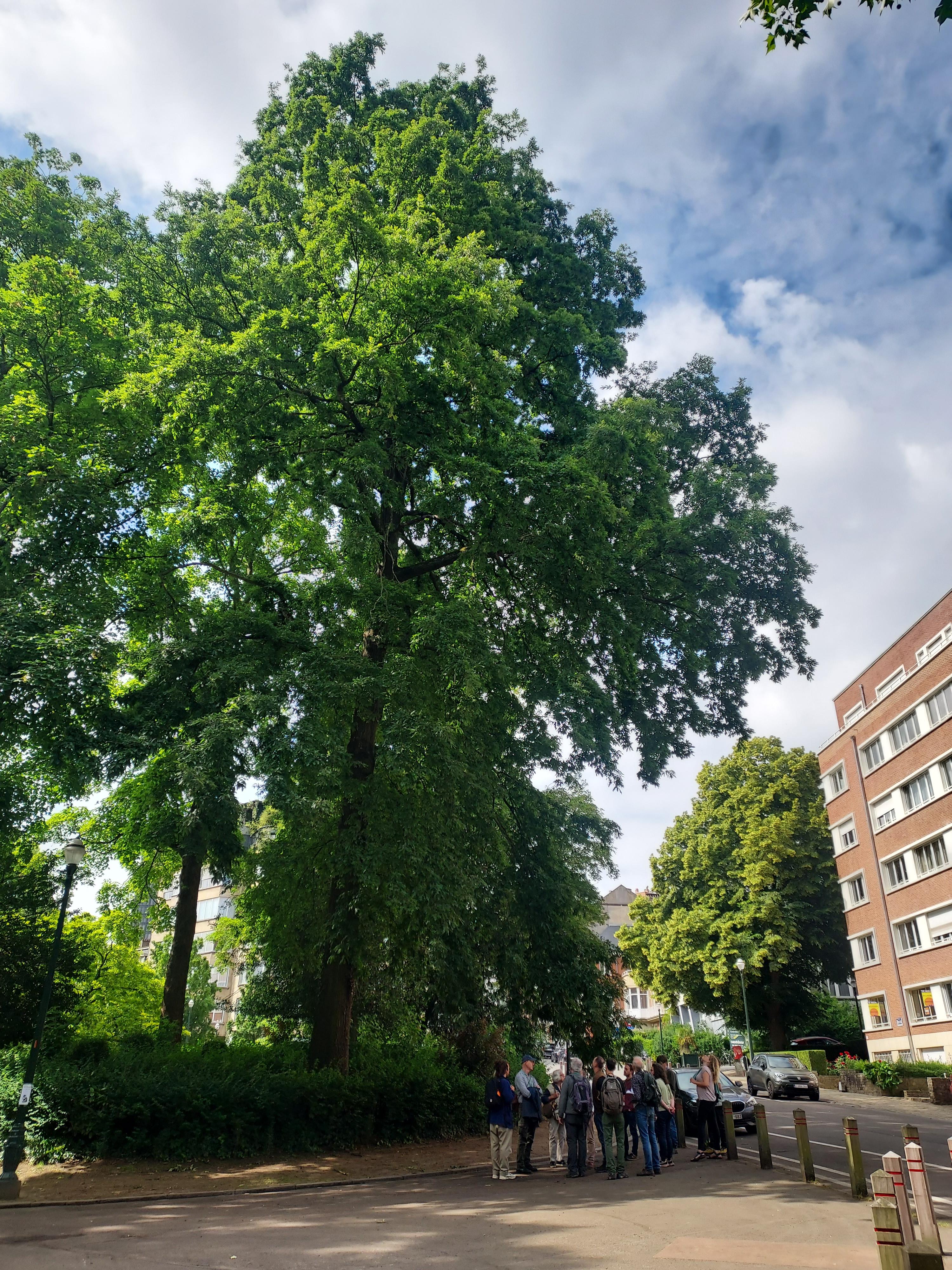
Founded in the 13th century, these now public gardens hold several oaks: a struggling Q. lobata, an unusual Q. ×comptoniae (a cross between Q. virginiana and Q. lyrata), and Q. buckleyi, a drought-tolerant red oak from the southern U.S. Many of these specimens were introduced thanks to Charles Snyers and his connections with the IOS.

Day 2, May 30 (afternoon): Arboretum Wespelaar and Herkenrode
by Jan Awouters
Our afternoon begins with a picnic on the sunny terrace of the Arboretum Wespelaar’s main building. Afterward, we will explore both the arboretum and the adjacent private garden of Herkenrode, home to renowned dendrologist Philippe de Spoelberch.

© Roderick Cameron
De Spoelberch began assembling his botanical collections at Herkenrode in the 1970s. As the garden quickly outgrew its original bounds, he expanded northward, leading to the establishment of the Arboretum Wespelaar in the mid-1980s. Managed by the Arboretum Wespelaar Foundation since 2001, the 20-hectare park now holds a world-class collection of approximately 2,300 tree and shrub species and cultivars, with an emphasis on wild-collected specimens. Among the arboretum’s key collections are Acer, Magnolia, Rhododendron, and Stewartia. The magnolia collection is especially notable, with 288 taxa as of 2024, including striking cultivars like Magnolia 'Daphne', bred on site.
Today, our focus is the oak (Quercus) collection, featuring over 100 species and cultivars. We begin with Q. ilicifolia, Q. marilandica, and their natural hybrid Q. ×brittonii, originally collected as wild acorns. We also observe Q. petraea ‘Columna’—a columnar cultivar likely of hybrid origin—more accurately known as Q. ×rosacea ‘Columna’. Striking spring foliage is on display in Q. robur ‘Concordia’, a brilliant yellow cultivar introduced by a Belgian grower in 1834, and its red counterpart, Q. robur ‘Atropurpurea’, a smaller German cultivar from 1864.
Beyond oaks, the arboretum offers many botanical highlights. We pause by a nearly spent Gleditsia sinensis, notable for its fierce thorns, and enjoy an exceptional flowering year for Maclura pomifera. A nearby male tree is covered in yellow-green flower clusters, while a female specimen grows further afield. Aesculus indica is also in bloom, but we return our attention to oaks. The arboretum’s Q. fabri is Belgium’s champion tree of the species, but it shows clear stress from the maritime climate. Other species observed include Q. hypoleucoides, Q. michauxii, Q. vulcanica, Q. phillyreoides, and Q. pyrenaica. Surprisingly, Q. oglethorpensis, once thought ill-suited to European climates, is thriving—one tree, planted from wild seed in 2005, is now Belgium’s largest.
Quercus parvula var. shrevei, native to California's moist coastal ranges, is healthy and visually distinctive. Three California-endemic varieties of this species are currently recognized. We also admire Q. kiukiangensis, a rare Chinese species introduced from Yunnan by Allen Coombes in 2004. Two healthy specimens at Wespelaar may lose leaves in harsh winters but remain vigorous. Also impressive is Q. calophylla (formerly Q. candicans), a young tree from Guatemala and Mexico that is surprisingly hardy here.
We end the day with a stroll through Herkenrode. Acer nipponicum is still in bloom, and Stewartia malacodendron stands out with its 60–90 mm flowers, white petals, and striking purple and blue stamens. Nearby grow Q. bicolor and Q. macrocarpa, the latter showing unusually pale leaf undersides.

Thank you, Philippe, for your generous hospitality, and to Joke Ossaer, Curator at Arboretum Wespelaar for guiding us round the oaks so efficiently!
Day 3, May 31 (morning): Kasteel van Widooie
by Christof van Hulle
The members of the International Oak Society gathered on a splendid Saturday morning to visit the arboretum of the Castle of Widooie, situated close to the oldest town of Belgium, Tongeren. The city is mentioned by Julius Caesar and is a genitive of Tungri, which is the name of the local tribe that lived there in the first century BC. The Castle of Widooie also has a rich history: it was originally a fortress and a priory in the early 800s, and its main objective was to fend off Vikings. The plan worked, as we didn’t see any Vikings during our visit to the arboretum surrounding the castle.

We were welcomed by Norbert de Schaetzen van Brienen, together with his son and granddaughter. Norbert started the arboretum and rose garden together with his wife, Françoise Begasse de Dhaem. The arboretum has around 350 species (focusing on oaks) and the rose garden 450 subspecies and varieties. The whole park exceeds 10 hectares.

Nineteen plots surround the castle, and we started our tour, after a brief welcome, with a walk straight to P15, where big oak trees were planted in 2003. Norbert asked us to check the labels and discuss the names. This was done eagerly. Many of the oaks had been received incorrectly labelled from nurseries: Quercus ×kewensis could be Q. macrolepis ? Quercus mexicana could be Q. canariensis ? Quercus mongolica could be Q. dentata? Quercus semecarpifolia could be Q. rugosa? Notes were taken and presented to our host at the end of the tour.

As these trees were planted already being big trees, you could see that some struggled but are pulling through now, while others did really well and are bound to be beautiful specimens. All the trees were planted at a great distance from each other, giving them the space they need. They are growing on slightly sloped land on each side of a country lane, with dense woodland on one side and a charming brook on the other. A lovely sight on a beautiful morning.

We left P9 and kept up a brisk pace to cross a large meadow and head for two big plots, left and right of the main entrance road where younger oak trees were planted. On the way there we saw a big specimen of Q. castanaefolia ‘Zuiderpark’ and again in P16.

The labels on these trees were correct. Beautiful Quercus palustris ‘Isabel’ (a dwarf cultivar), healthy Quercus robur ‘Timuki’ (purple-leaved) … North American oaks, Mexican oaks, Asian oaks. These two plots are going to be the highlight of the park in the near future, perhaps even in a couple of years when these trees flourish. This last spring has been very dry, but there is a lot of work done to adequately drain these plots to prevent flooding when weather conditions are wet.

We concluded the tour on the last plot, P19, also called ‘The Nursery’. Here young specimens, one-year- and two-year-old plants, were planted close together in rows. The aim is to let them grow and be maintained as young trees well, then plant them out in the arboretum in years to come. You could see that not only the arboretum is growing, but also the knowledge of trees and the contacts with other arboreta are expanding.

Slightly behind schedule, we headed back to the castle to enjoy our lunch before going to our afternoon stop—the Bokrijk Arboretum. Thank you, Norbert and family, for your hospitality!
Day 3, May 31 (afternoon): Bokrijk Arboretum
by Christof Van Hulle
I had been to the Arboretum at Bokrijk a long time ago, on school trips. The open air museum is very well known in Belgium and beyond. It occupies more than 550 hectares and hosts around 140 buildings from the 1600s and later. This museum is often used as a film set. The Arboretum is less well-known but certainly worth a visit.

It started as a park around the castle, which was built around the turn of the 20th century, with now big native trees, and in 1965 the Belgian government decided to start the Arboretum. The Arboretum is large, covering 18 hectares. They host large collections of Ilex, Magnolia, and Rhododendron. It also hosts the national bamboo collection and they have a big collection of ferns.
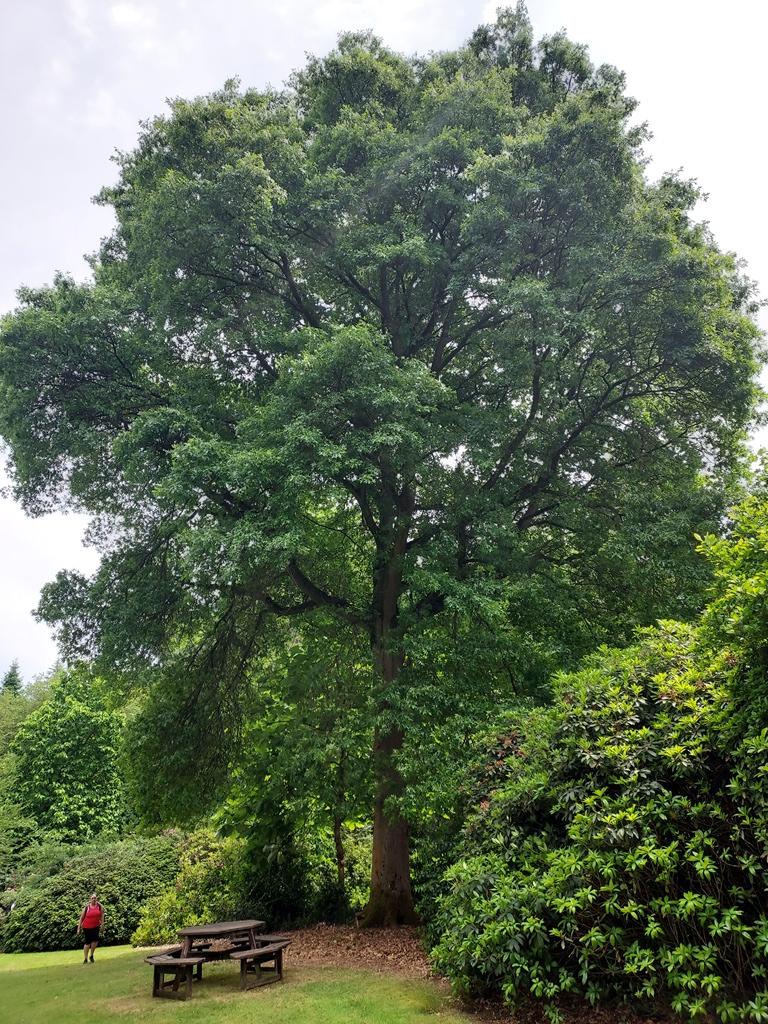
Sven Bronckaers guided us on our visit. He is the Heritage Gardener and knows the Arboretum by heart. Guidance was necessary as the winding garden path takes you to different types of gardens. This is a mixed garden and that means we had to go the extra mile to see all the Quercus. Planting oak trees started in the '80s and continued all through the '90s and 2000s, so the trees we saw are between 20 and 40 years old.

There were only mild discussions about the names. I counted 96 Quercus species on the list we were given. One that really stood out was a Q. pyrenaica: standing on the edge of a border and with enough space to become a large specimen, not a cultivar, but so pale grey it could easily have been. The same morning at Widooie we had discussed a Q. ×turneri ‘Pseudoturneri’ which was doubtful, but here opinions were unanimous.

In the middle of the Arboretum, there is an abandoned structure that normally is not open to the public, but Sven had the key. This was formerly an office, but the government decided to abandon it. As part of an art project, ‘Nature is taking back the building’, it is now overgrown. There are many doubts about the future of this building, as some trees (like Firmiana simplex—this specimen is the Belgian champion) would be damaged during a restoration.

It was a beautiful hot day, and the air was kept cool by the big trees. Well after 18:00 and beyond the scheduled end of our visit, the group split up, and die-hard oakies went with Sven to see some hybrids.

We concluded the tour with a speech from our President, Roderick, thanking Sven for all the valuable information he gave us, making him a member of the IOS (Sven seems to be currently preoccupied with ferns, but we expect this will be a passing phase before he becomes a fervent quercophile!) and handed over a cap of the IOS for the sunny summer to come.
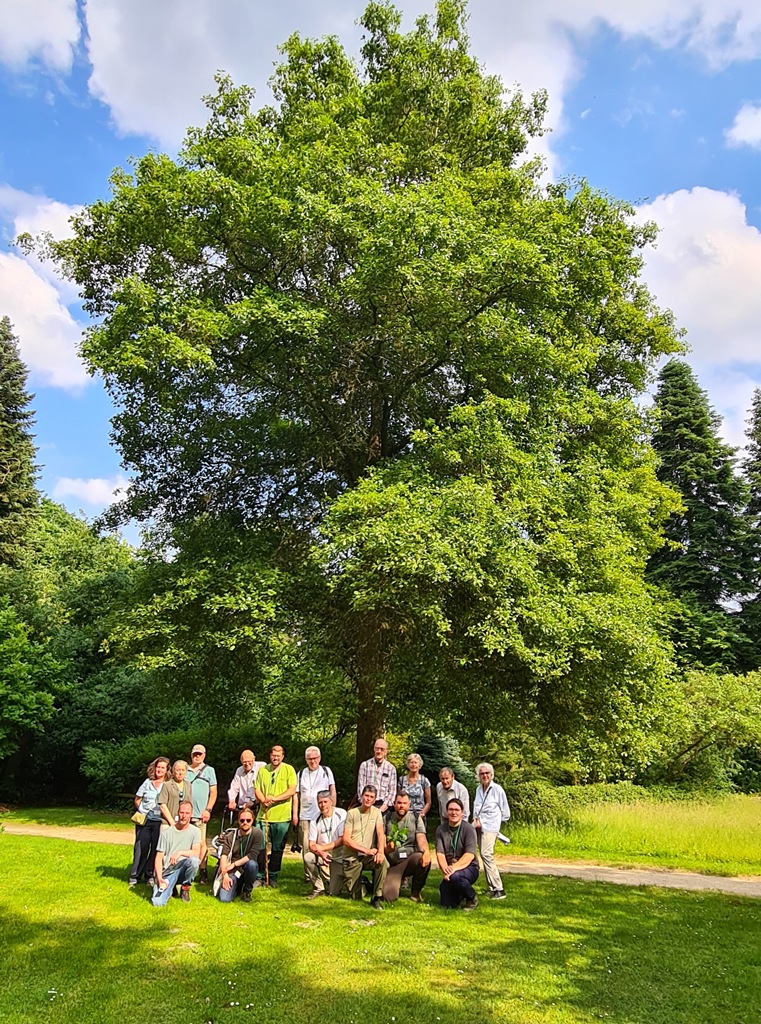
Day 4, June 1: Plantentuin Meise
by Jan Awouters
Our final day was spent at the Plantentuin Meise, where Karel De Gendt welcomed and guided us through this remarkable botanical garden. Spanning 92 hectares, it is one of the largest botanical gardens in the world and has a history stretching back over 200 years.

The estate, centered on the Castle of Bouchout, dates to 1300. In 1879, King Leopold II purchased the castle for his sister Charlotte, widow of Emperor Maximilian of Mexico. In 1884, Leopold also acquired the nearby Castle of Meise, merging both into a grand estate. The Belgian state bought the property in 1938 to create the National Botanic Garden, renamed Plantentuin Meise in 2014 under the Flemish government.

The oak collection is a major highlight, with over 200 specimens—many wild-collected—grouped in a dedicated Quercetum. The garden aims to DNA-sequence these trees for accurate identification and to study genetic diversity. Future efforts will prioritize genetic breadth within species over sheer species number.

The native Q. robur is well-represented, especially in the forested areas, where some trees are over 100 years old. Notable European species include Q. ×hispanica ‘Ambrozyana’, ‘Fulhamensis’, ‘Lucombeana’, Q. alnifolia, Q. coccifera, and Q. pyrenaica.
North American oaks are well represented too: Q. oglethorpensis, Q. vaseyana, Q. serrata, Q. stellata, Q. georgiana, Q. muehlenbergii, Q. lyrata, and the hybrid Q. ×bushii (a cross between Q. falcata and Q. stellata), known for its resilience.

Asian species viewed included Q. myrsinifolia, Q. variabilis, Q. acutissima, and Q. tatakaensis, endemic to central Taiwan.
After the official tour, those with time left were free to explore the garden further at their leisure. With that, as participants thanked Karel for an excellent visit, bid farewell, and departed in different directions, our intense four-day event drew to a close.
1 IOS members can add a comment below (you must first log in with your username and password)

